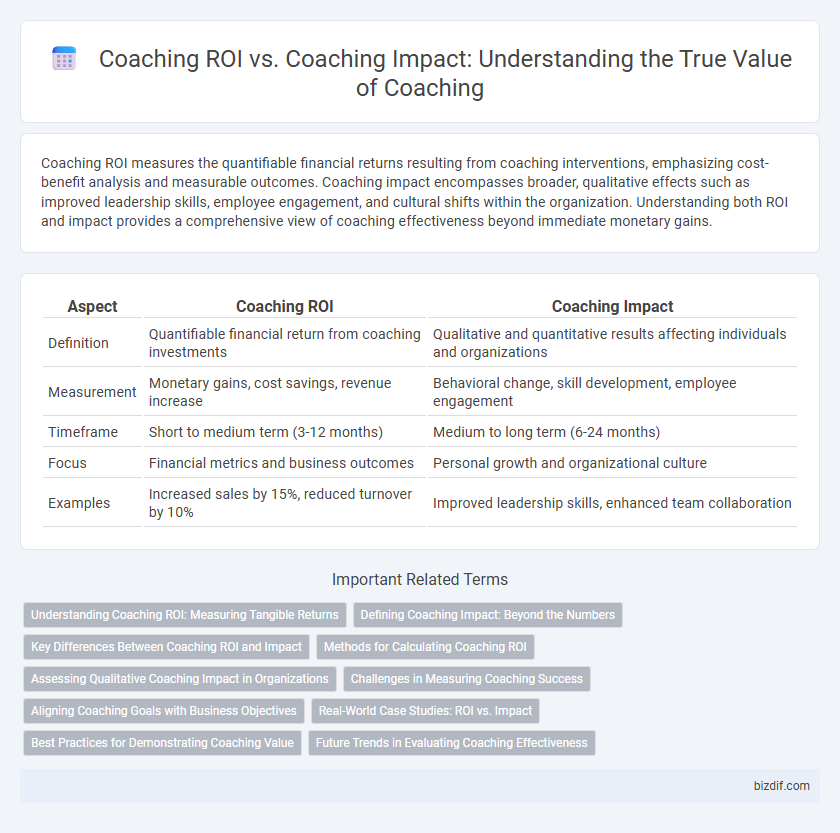Coaching ROI measures the quantifiable financial returns resulting from coaching interventions, emphasizing cost-benefit analysis and measurable outcomes. Coaching impact encompasses broader, qualitative effects such as improved leadership skills, employee engagement, and cultural shifts within the organization. Understanding both ROI and impact provides a comprehensive view of coaching effectiveness beyond immediate monetary gains.
Table of Comparison
| Aspect | Coaching ROI | Coaching Impact |
|---|---|---|
| Definition | Quantifiable financial return from coaching investments | Qualitative and quantitative results affecting individuals and organizations |
| Measurement | Monetary gains, cost savings, revenue increase | Behavioral change, skill development, employee engagement |
| Timeframe | Short to medium term (3-12 months) | Medium to long term (6-24 months) |
| Focus | Financial metrics and business outcomes | Personal growth and organizational culture |
| Examples | Increased sales by 15%, reduced turnover by 10% | Improved leadership skills, enhanced team collaboration |
Understanding Coaching ROI: Measuring Tangible Returns
Measuring coaching ROI involves quantifying tangible business outcomes such as increased productivity, improved employee retention, and enhanced leadership effectiveness. Effective metrics include performance improvements, cost savings, and revenue growth directly linked to coaching interventions. Understanding these concrete returns enables organizations to justify coaching investments and align them with strategic goals.
Defining Coaching Impact: Beyond the Numbers
Coaching impact transcends simplistic ROI calculations by capturing qualitative transformations such as enhanced leadership skills, employee engagement, and cultural shifts within organizations. Measuring coaching impact involves assessing changes in behavior, mindset, and long-term performance improvements that are often intangible yet critical for sustained success. This holistic approach ensures a deeper understanding of coaching value beyond mere financial metrics.
Key Differences Between Coaching ROI and Impact
Coaching ROI measures the quantifiable financial return from coaching investments, focusing on metrics such as increased revenue, reduced turnover costs, and productivity improvements. Coaching impact encompasses broader qualitative outcomes, including enhanced employee engagement, leadership development, and cultural transformation. Key differences lie in ROI's emphasis on tangible financial metrics, while impact captures long-term behavioral and organizational changes beyond immediate monetary gains.
Methods for Calculating Coaching ROI
Methods for calculating coaching ROI typically involve evaluating key performance indicators such as increased productivity, employee engagement scores, and retention rates to quantify financial returns. Techniques like the Phillips ROI Methodology compare coaching costs against measurable benefits, including revenue growth and reduced absenteeism, to determine monetary value. Combining qualitative feedback with quantitative data ensures a comprehensive assessment of coaching impact beyond simple economic metrics.
Assessing Qualitative Coaching Impact in Organizations
Assessing qualitative coaching impact in organizations involves measuring changes in employee engagement, leadership effectiveness, and team collaboration that are not easily quantified. Unlike coaching ROI, which focuses on direct financial returns, qualitative impact emphasizes improved communication, increased morale, and enhanced problem-solving skills. These factors contribute to sustainable organizational growth and long-term cultural transformation beyond immediate economic metrics.
Challenges in Measuring Coaching Success
Measuring coaching ROI faces significant challenges due to the intangible nature of outcomes like improved leadership and employee engagement, which are difficult to quantify precisely. Coaching impact extends beyond immediate financial returns, involving long-term behavioral changes and organizational culture shifts that traditional ROI metrics often overlook. Data inconsistencies, varying definitions of success, and isolating coaching effects from other business interventions complicate the accurate assessment of coaching effectiveness.
Aligning Coaching Goals with Business Objectives
Aligning coaching goals with business objectives ensures measurable coaching ROI by directly linking development outcomes to key performance indicators such as productivity, employee engagement, and revenue growth. Clear alignment facilitates targeted coaching interventions that drive strategic priorities, maximizing both short-term results and long-term organizational impact. Effective coaching focuses on skills and behaviors that support business goals, enabling precise evaluation of coaching effectiveness and return on investment.
Real-World Case Studies: ROI vs. Impact
Real-world case studies demonstrate that coaching ROI often measures immediate financial returns, such as increased productivity and reduced turnover costs, while coaching impact captures broader, long-term benefits like enhanced leadership skills and employee engagement. Companies investing in coaching report ROI ranging from 5 to 7 times the initial investment, yet the qualitative impact on organizational culture and innovation is harder to quantify but equally critical. These case studies highlight the importance of balancing both ROI metrics and coaching impact assessments to fully understand coaching's value in business growth.
Best Practices for Demonstrating Coaching Value
Measuring Coaching ROI requires quantifying financial returns such as increased productivity, reduced turnover costs, and revenue growth attributed to coaching interventions. Coaching impact encompasses qualitative outcomes like enhanced leadership capabilities, employee engagement, and cultural transformation within organizations. Best practices for demonstrating coaching value include implementing pre- and post-assessments, leveraging 360-degree feedback, and using data analytics to link coaching activities with business performance metrics.
Future Trends in Evaluating Coaching Effectiveness
Emerging trends in evaluating coaching effectiveness emphasize integrating real-time data analytics and AI-driven assessments to measure both coaching ROI and long-term impact on employee performance. Organizations increasingly adopt holistic evaluation frameworks that consider qualitative outcomes such as leadership development, employee engagement, and cultural transformation alongside traditional financial metrics. Future-focused coaching evaluations prioritize continuous feedback loops and predictive analytics to enhance strategic decision-making and demonstrate sustained value.
Coaching ROI vs coaching impact Infographic

 bizdif.com
bizdif.com